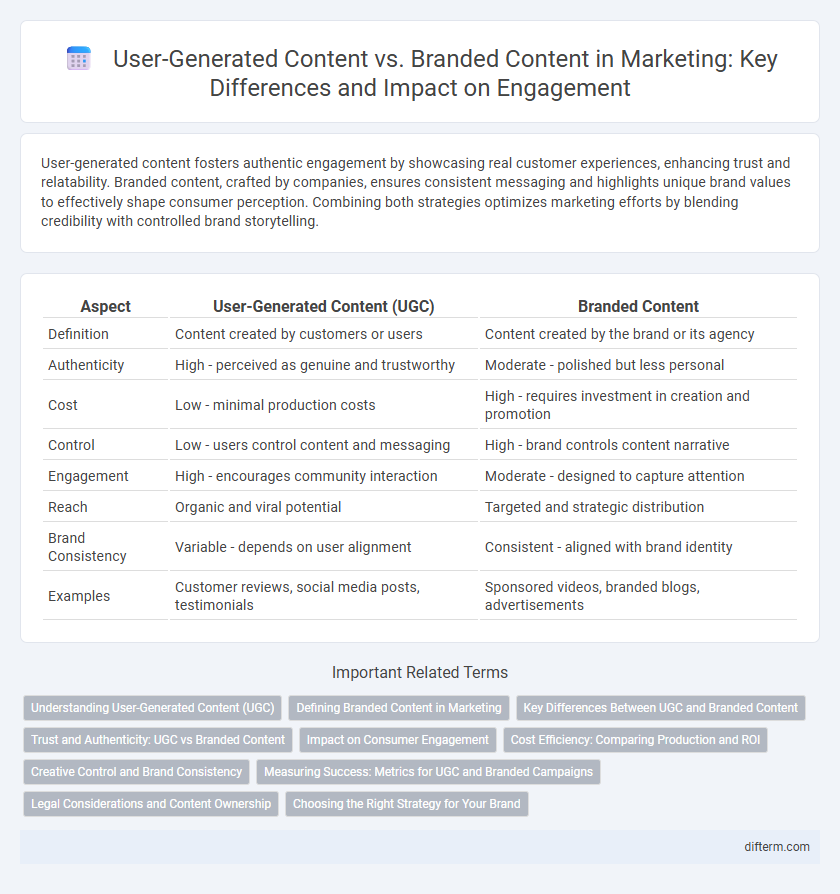User-generated content fosters authentic engagement by showcasing real customer experiences, enhancing trust and relatability. Branded content, crafted by companies, ensures consistent messaging and highlights unique brand values to effectively shape consumer perception. Combining both strategies optimizes marketing efforts by blending credibility with controlled brand storytelling.
Table of Comparison
| Aspect | User-Generated Content (UGC) | Branded Content |
|---|---|---|
| Definition | Content created by customers or users | Content created by the brand or its agency |
| Authenticity | High - perceived as genuine and trustworthy | Moderate - polished but less personal |
| Cost | Low - minimal production costs | High - requires investment in creation and promotion |
| Control | Low - users control content and messaging | High - brand controls content narrative |
| Engagement | High - encourages community interaction | Moderate - designed to capture attention |
| Reach | Organic and viral potential | Targeted and strategic distribution |
| Brand Consistency | Variable - depends on user alignment | Consistent - aligned with brand identity |
| Examples | Customer reviews, social media posts, testimonials | Sponsored videos, branded blogs, advertisements |
Understanding User-Generated Content (UGC)
User-Generated Content (UGC) encompasses authentic media created and shared by consumers rather than brands, driving higher engagement through genuine customer experiences. UGC builds trust and community by showcasing real-life usage and testimonials, often outperforming branded content in credibility and relatability. Marketers leveraging UGC harness social proof, increasing brand awareness and influencing purchasing decisions more effectively than traditional advertising.
Defining Branded Content in Marketing
Branded content in marketing refers to promotional materials created by a company to build brand awareness and foster consumer engagement through storytelling aligned with the brand's values and identity. Unlike user-generated content, which originates from consumers and advocates authentic, sometimes unsolicited endorsements, branded content is strategically designed to convey specific brand messages and emotional connections. This type of content often includes videos, articles, and social media campaigns that subtly integrate the brand without overt sales pitches, aiming to enhance brand loyalty and recognition.
Key Differences Between UGC and Branded Content
User-generated content (UGC) originates directly from consumers, offering authentic, relatable experiences that enhance trust and engagement, whereas branded content is professionally created by companies to strategically communicate brand messaging and values. UGC often drives higher social proof and organic reach due to its peer-to-peer nature, while branded content provides consistent brand storytelling aligned with marketing campaigns. Key differences include content control, source of creation, and audience perception, with UGC prioritizing authenticity and branded content emphasizing brand authority.
Trust and Authenticity: UGC vs Branded Content
User-generated content (UGC) fosters higher trust and authenticity among consumers by showcasing real experiences and unfiltered opinions, which branded content often lacks due to its promotional nature. Studies reveal that 79% of consumers find UGC more trustworthy than traditional advertising, enhancing brand credibility and engagement. Brands leveraging UGC see increased authenticity that drives stronger emotional connections and loyalty compared to polished branded campaigns.
Impact on Consumer Engagement
User-generated content (UGC) drives higher consumer engagement by fostering authenticity and trust, as audiences perceive real customer experiences as more relatable than traditional branded content. Branded content, while controlled and polished, often struggles to elicit the same emotional connection, limiting its ability to generate genuine interaction. Metrics show that campaigns incorporating UGC achieve up to 28% more engagement and 50% higher conversion rates compared to solely branded content strategies.
Cost Efficiency: Comparing Production and ROI
User-generated content (UGC) significantly reduces production costs by leveraging authentic contributions from customers, minimizing the need for expensive professional resources. Branded content often requires substantial investment in creative development, media buying, and production, which can limit ROI if not executed effectively. Studies show UGC campaigns can yield 4 times higher engagement and 2 times better ROI due to lower costs and greater consumer trust compared to traditional branded content.
Creative Control and Brand Consistency
User-generated content offers authentic engagement through diverse consumer voices but limits creative control, as brands cannot dictate the messaging or aesthetics. Branded content ensures tight brand consistency by maintaining strict oversight over visuals, tone, and messaging, reinforcing the brand identity across all channels. Balancing the spontaneity of user-generated content with the precision of branded content optimizes marketing strategies for maximum impact.
Measuring Success: Metrics for UGC and Branded Campaigns
User-generated content (UGC) success is measured through engagement metrics such as likes, shares, comments, and conversion rates driven by authentic customer interactions. Branded content effectiveness relies on brand recall, reach, and impact on purchase intent, often tracked via surveys, click-through rates, and ROI analysis. Combining UGC and branded content metrics provides a comprehensive view of campaign performance by balancing authenticity and controlled messaging.
Legal Considerations and Content Ownership
User-generated content (UGC) requires clear agreements on content ownership and usage rights to avoid legal disputes and ensure proper attribution. Branded content typically involves contracts that specify intellectual property rights and distribution permissions, protecting both the brand and content creators. Marketers must navigate copyright laws and obtain explicit consent to use UGC commercially, maintaining compliance with regulations such as the Digital Millennium Copyright Act (DMCA).
Choosing the Right Strategy for Your Brand
User-generated content (UGC) drives authenticity by leveraging customer voices and real experiences, boosting engagement and trust more effectively than traditional branded content. Branded content offers complete creative control and consistent messaging, essential for building clear brand identity and aligning campaigns with business goals. Evaluating your brand's target audience, marketing objectives, and resource availability helps determine whether UGC's organic reach or branded content's precision better suits your strategy for maximum impact.
user-generated content vs branded content Infographic

 difterm.com
difterm.com